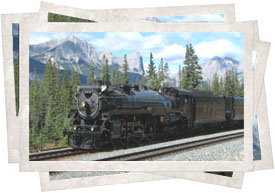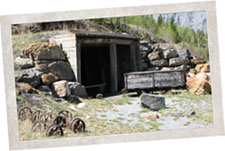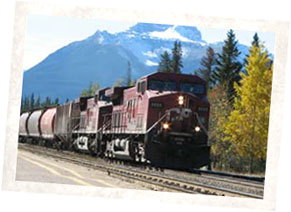About Canmore history
Founded in 1883 as a railway division point and mining town, Canmore today provides services for the entire Bow Valley, and is also recognised worldwide as one of North America's best outdoor recreational and adventure centres.
Canmore was created from humble beginnings, a significant vein of coal and CPR's creation of a switching station were all that was needed for it to become a settlement at the gateway to the Rockies.

CPR Empress steam train
The enviable reputation that Canmore now enjoys can be almost entirely laid at the door of the Canadian Pacific Railway. The CPR almost singlehandly responsible for creating Canmore and it's neighbouring town of Banff.
In 1884 the first CPR train rumbled through Canmore and a small settlement appeared. Named after Malcolm Canmore, a Scot from the UK, the town attracted working men and their families.
In 1887 the first coal mine opened below Chinaman's Peak (now known as Ha Ling Peak). The mines produced coal, the railway moved freight & coal, and Canmore was a dusty town with a permanent pall of coal smoke over it.
In 1888 the first Canmore baby was born into a rapidly expanded town, now including bakeries, dairies and stores. In 1891 the first church was built, and then in 1894 a log schoolhouse was constructed for the children of Canmore.
Canmore was part of the Banff National Park until 1930 when the National Park Act deemed it inappropriate for mining to take place in a National Park. Because the mine was a profitable enterprise it clearly wasn't an option to close it. So they simply moved the park boundaries to place the mine, and Canmore, outside of the Banff National Park boundaries.

In 1979 the last coal mine closed and the outlook for Canmore was bleak. For almost a decade Canmore was no more than a place to stop for gas travelling to or from Banff National Park. However in 1988 something happened that changed Canmore's life forever.
The 1988 Calgary Winter Olympic Games arrived, and as part of that event the Canmore Nordic Centre was built specially to host the cross-country ski and biathlon events. Canmore never looked back. People began to realise the almost unlimited recreational possibilities available at the entrance to the Rockies, and Canada and the rest of the world began to take notice of the small mining town catapaulted into the worlds eyes as a result of the 1988 Winter Olympics.
Today the Nordic Centre is still much in use for world-class sporting events and recreational use. In 2005 it underwent a massive upgrade, with financial investment of $16.5 million, to prepare for the Alberta Centennial World Cup 2005.
Canmore today is expanding at an enormous rate. Development has seen it rise from a small mining town to a highly sought after mountain resort location.
The town has several provincial heritage sites, including the NWMP Barracks which has been restored to its 1921 state and is now run as a tea room and gift shop, you can stop there for a cup of tea and a slice of apple pie in the garden.
In total there are eight historical sites in the town centre, including a house built in 1908 for HR Young, one of the first mine managers. The heritage walking tour will take you through Canmore's history, and the Canmore Museum will show you the harsh reality of life and mining in early Canmore.

Canadian Pacific Railway train
But to ensure that Canmore doesn't completely forget its roots, the rumble of the Canadian Pacific Railway trains day and night through the centre of Canmore are there to remind residents of its humble beginnings.
